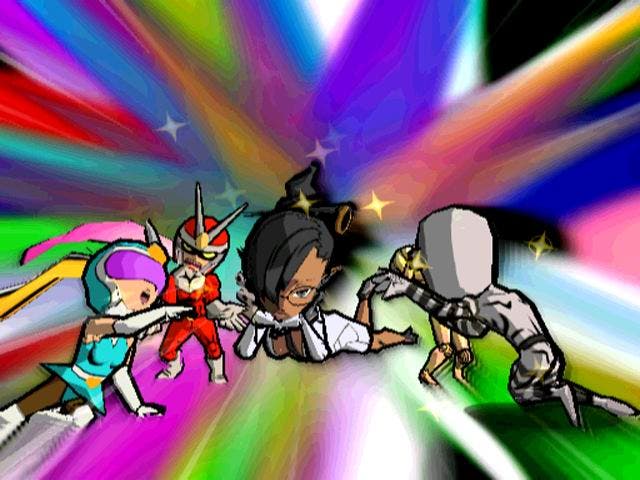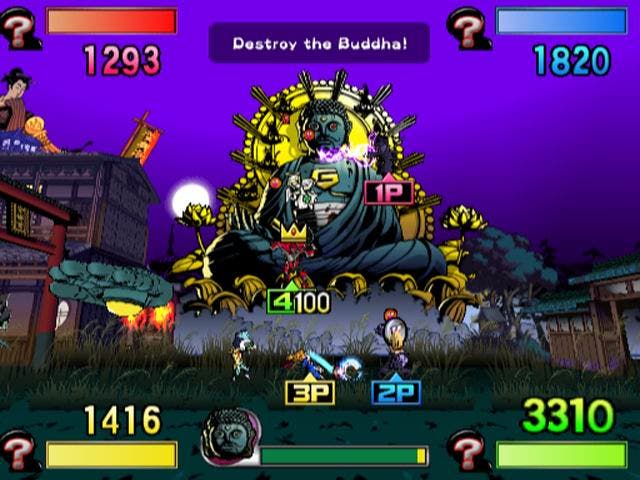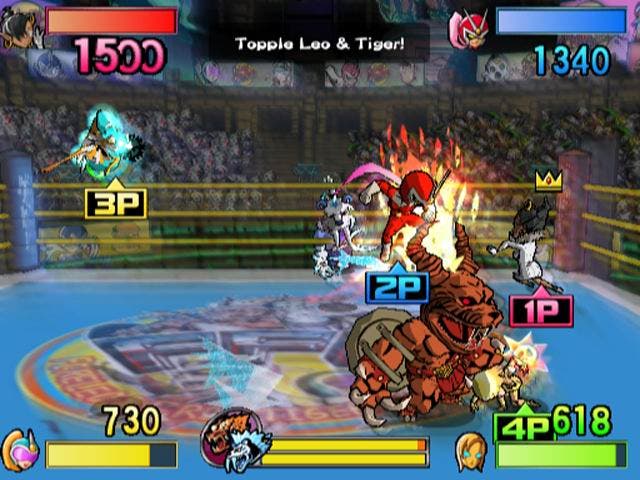Viewtiful Joe: Red Hot Rumble
Stupor Smash Bros.
It's a source of great pride for me that I can get through an entire festive period without having my doorstep - let alone the inside of my house - polluted by the presence of other people. If the revolution comes tomorrow, and all of London is a blizzard of flying bricks, people will know who they can turn to for shelter: everyone else. I like people outside. I just don't want them in here.
So, I rarely invite them in. Except, of course, for this one time, three and a half years ago, when a little disc with "Super Smash Bros. Melee" written on it span around the clippy bit under my GameCube lid. I practically left my door open.
The developers of Viewtiful Joe seem to have noticed this. Red Hot Rumble suggests that they picked up Smash Bros. and asked themselves, "Hey, we're already a bit like that - what if we went the whole way?" What indeed. Shall I open the door again?
The game begins with typical fanfare and manic introduction, through which you'll eventually establish that Captain Blue - Viewtiful Joe's silver-screen idol and occasional saviour of the world and so on - is retiring, and a number of heroes and villains are auditioning to fill his spandex by battling it out over a range of movie productions.
This is all presented in a manner similar to Smash Bros, where 2d characters batter each other using basic attacks and power-ups as they leapt around a platform-dotted single 2d screen. Here, you and your computer opponents or friends or strangers or that rowing couple next door (SHUT! UP!) take to the play area and battle to collect coins and complete objectives, like collecting gems or dispatching rank-and-file fist fodder, pummelling each other for kicks (and bonuses).
You can jump, double-jump, drop behind a platform down to the ground with down-and-A, and put to use a range of special attacks adapted from the Viewtiful Joe games. Objectives vary - you might have to dodge particular attacks, take down one of the series' familiar bosses, position yourself on the right side of a closing gate several times in succession - but the usual theme is to end up with more loot than your main opponent, who's trying to achieve the same goals. The loss of all your health is punished by the distribution of some of your prized coins around the screen area before you're parachuted back into the fray.

Viewtiful Joe's range of VFX powers seem like an ideal fit. Slow-mo slows the world for everyone but you and mach speed speeds you up, and these and other powers are available from drop-in power-ups, which you can activate when it's most advantageous. You don't worry about ducking and weaving and plotting combos like you did in Viewtiful Joe 1 and 2; this is about grabbing whatever's to hand, putting it to use at the right moment and looting and rebuffing in the meantime. For example, dodging your opponent's attacks, grabbing a slow-mo capsule and using it to slow down an otherwise impenetrable tornado of rotating goons long enough for you to rack up the kills.
The screen's a near-continuous explosion of bright colours, thrashing sprites and special effects. Objects both useful and deadly are always tumbling around you, sometimes telegraphed by VJ's trademark skull evasion icon, while bits of the foreground and background jostle to interfere, barrels are pounded toward enemies, coins materialise in every corner and everything tries to barge everything else out of the way for screen-space until a truce is struck and they simply overlap instead.
With so much going on, it's at once incredibly important and incredibly difficult to keep a handle on your actions, because simply mashing attack buttons is tremendously unhelpful. Attacking often freezes you whether on the ground or in mid-air as you take your swipe, while other moves thrust you into uninterruptible routines - all of which puts you at risk of harm unless you're mindful of it. Annoyingly, being mindful is often the last thing your fingers are prepared to do. Use your sliding special while your opponent's locked in an impervious flashing state, and he'll probably just whack you - obvious, but not exactly easy to judge when half the pixels in view are channelling Japanese Seizure Robots.

On top of this, Red Hot Rumble also features some cute reaction-based and mashing interludes activated through certain power-ups, which teleport you into little sideshows. These are a bit frustrating and poorly explained to start with, but as soon as you've seen them once or twice you get the gist and revel in the mini-victories, which are equivalent to knocking the stuffing (and coins) out of your opponent.
It's also been designed to appeal to and charm existing fans - the Zoom power, for example, manifests itself by increasing your character's size by about ten times, allowing you to stomp around like a maniac.
Yet, in a sense, the Zoom is symptomatic of what RHR gets wrong. The degree to which you become large is disproportionate to the power you assume; you grow, but you feel rather limp and ineffective, as though you're trying to punch fleas with boxing gloves. Meanwhile, Viewtiful Joe's sense of humour is largely confined to tedious text boxes on the mission-select screen. Also weird.
Battles are chaotic, but this is not the structured Smash Bros. melee - this is just sheer chaos. You lose track of your character easily, particularly during multiplayer bouts of more than two players. Smash Bros. worked in such a way that you could tell when a game was closely fought, and you watched the stats summary with cautious optimism, and giggled at the rewards and abuse it dished out. Here you struggle to grasp who has the upper hand, or even whose hand it is that's in view. There were times when I thought I'd dealt a boss a fatal blow and reeled back in satisfaction as the game awarded me a "Viewtiful" award - good for a fair few extra coins - only to lurch forward in confusion again when I realised it was actually going to my opponent's character, along with the result.

The many characters also seem to be unbalanced. This is less of a concern in single-player, where each one offers a different approach to master, but it's maddening when you're fighting a friend and he's simply better at all the crucial things by design.
After a number of hours tinkering with it, I just gave up. You have to be patient and strict with your behaviour, which is utterly at odds with what you're actually seeing on the screen, and while that works fine for some (hello shoot-'em-up genre), this is hardly the pyrotechnical capoeira of Ikaruga; it's fly-fishing in a gale. Even as I tried to be cautious I struggled to become truly competent, or to get a complete handle on what the hell was going on. Often it feels like the developers tried to channel every bit of VJ's distinctiveness onto the screen at once, serving the material rather than the fundamental game idea in the process.
That idea - of grafting VJ's mechanics and VFX powers onto the skeleton of Smash Bros. - sounds wonderful on paper. But as with all such procedures there are downsides, and RHR has had more than a facial transplant. There's a mess of nerves that throb confusedly beneath its borrowed face. It looks about right, certainly, but you'll need more than immunosuppressants to stop your face exploding in outrage half the time.
So, in the end, the door stays shut.

